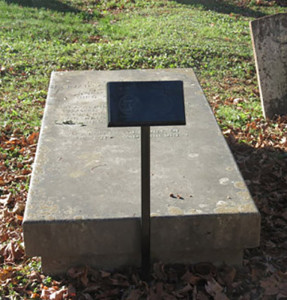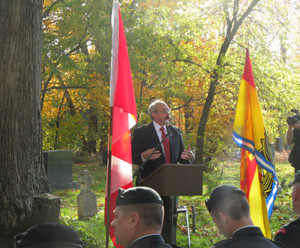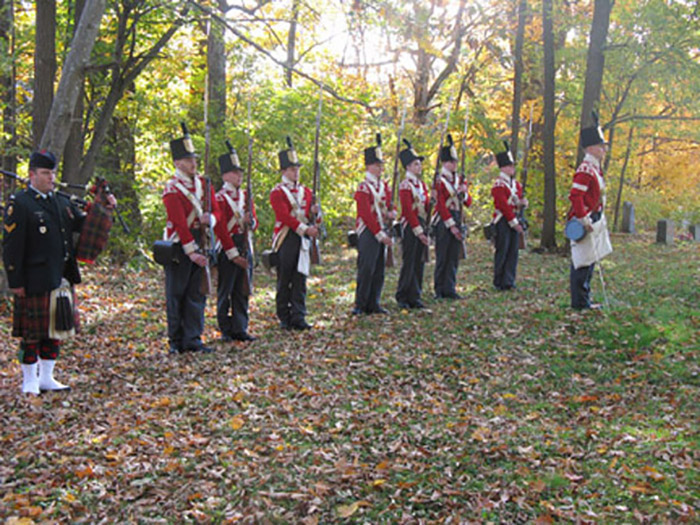Charles Rainsford was commissioned as an Ensign in the New Brunswick Regiment of Fencible Infantry on 17 July 1806 and was promoted to Lieutenant on 25 November 1808. The regiment was elevated to line status in 1810 and became the 104th Regiment of Foot. Rainsford participated in the epic march from Fredericton to Kingston in the winter of 1813 and appears to have been at the Battle of Sackets Harbor on 29 May 1813. He served with the regiment in Upper Canada (Ontario) during the war and in Lower Canada (Quebec) after the war ended. Rainsford was promoted to Captain on 6 June 1815.
 In August 1816, he exchanged out of the regiment to the New Brunswick Fencibles and returned to Fredericton, New Brunswick where he married in 1817. In his civilian life, he was a farmer and government official, rising to the position of Receiver General for New Brunswick. He lived in Kingsclear and died there on 24 April 1882 at the age of 94.
In August 1816, he exchanged out of the regiment to the New Brunswick Fencibles and returned to Fredericton, New Brunswick where he married in 1817. In his civilian life, he was a farmer and government official, rising to the position of Receiver General for New Brunswick. He lived in Kingsclear and died there on 24 April 1882 at the age of 94.
New Brunswick’s 104th Regiment of Foot formed part of the garrison in New Brunswick and adjoining Prince Edward Island and Cape Breton. In February 1813, six of the eight companies of the regiment in New Brunswick were ordered to march to Lower Canada. The British were anticipating that the Americans would attack early in the spring, before the St. Lawrence River opened to shipping and reinforcements could arrive at Quebec City. Because the threat of any land operations was low in the Maritimes, General Prevost made the strategic gamble to send the 104th to the Canadas.
 Unbeknownst to them, the six companies would embark on an epic march of over 1,100 kilometres that would eventually bring them to Kingston, Upper Canada. The march from Fredericton to the St. Lawrence River would be done on snowshoes with the soldiers pulling their kit on toboggans. While en route, they were beset by unusually cold temperatures and continuing heavy snowfalls. The first company with the headquarters left Fredericton on 16 February with the last one, the Light Company, departing on 21 February.
Unbeknownst to them, the six companies would embark on an epic march of over 1,100 kilometres that would eventually bring them to Kingston, Upper Canada. The march from Fredericton to the St. Lawrence River would be done on snowshoes with the soldiers pulling their kit on toboggans. While en route, they were beset by unusually cold temperatures and continuing heavy snowfalls. The first company with the headquarters left Fredericton on 16 February with the last one, the Light Company, departing on 21 February.
Lieutenant Charles Rainsford marched out with Captain George Armstrong’s No. 6 Battalion Company on 20 February. Their route was up the St. John River to the Madawaska River, across Lake Temiscouata and the Grand Portage, to the St. Lawrence River which they followed to Kingston.
The soldiers left with 14 days rations but the hard work under extremely cold and difficult conditions caused them to progress more slowly than anticipated and to consume their rations more quickly than planned. By the time each company reached D’egelis, at the junction of the Madawaska River and Lake Temiscouata, they had essentially exhausted their rations but they still had three days march across the lake and the Grand Portage to the St. Lawrence River and a fresh supply of food.
Captain Armstrong’s company reached D’egelis on 4 March. The next day, a fierce north-wester, with intense cold and strong winds, started. The weather was so bad that, while the company started out to cross the ice of Lake Temiscouata to reach Philip Long’s farm at the entrance to the Grand Portage, they were forced to turn back and return to the huts where they had spent the previous night.
Meanwhile, Captain George Shore’s Light Company had braved the storm and arrived at D’egelis about mid-afternoon. Every soldier was suffering from the cold and about 90 of the 105 men had various degrees of frostbite. With food in short supply, the officers held a consultation. If fresh food could not be obtained, then many of the men were likely to die from the effects of cold and hunger. Lieutenant Rainsford volunteered to go for help and, accompanied by Private Peter Patnot (Patinaude) of the Light Company, started out on their rescue mission that evening.
As Rainsford and Patinaude struggled to cross the lake in the face of the storm, they encountered Phillip Long who had been searching for Captain Armstrong’s company after it failed to reach his farm that day. Long took them to his farm, fed them, and then set them on the path of the Grand Portage. They snowshoed all night until they reached the St. Lawrence River where they met William Anderson, the Commissariat contractor.
Rainsford organized a rescue party and returned to Long’s farm with a supply of food. Meanwhile, the storm had abated and the two companies had been able to cross the lake. They arrived at Long’s farm on the afternoon of 6 March where, at some point in time, they met Rainsford and his rescue party. Rainsford and Patinaude had travelled 90 miles (145 kilometres) in two days and the troops had been without food for over 30 hours. By following the time line, it is clear that they performed this amazing journey in about a day and a half and had actually travelled about 96 miles or 150 kilometres. By their heroic actions, Rainsford and Patinaude had saved the lives of upwards of 200 of their comrades!
Rainsford believed that he should have received some recognition for this heroic deed and so, in February 1847, he petitioned the Government of New Brunswick for a grant of money that would enable him to purchase some land. The facts of his petition were certified by George Shore, who had commanded the Light Company, and William Woodford, who had been the regiment’s Assistant Surgeon. The Legislative Assembly authorized a payment of £6/5s to Rainsford that allowed him to purchase 500 acres of Crown Land. In June 1866, Rainsford submitted a similar petition to the British government.
Although this was an unusual request, Sir Arthur Hamilton Gordon, the Lieutenant Governor, recommended it be granted. The British government agreed and over ten years later, in September 1876, Rainsford was granted an annual pension of £100. In his second petition, Rainsford said he had been accompanied by a second volunteer, Private Jean Baptiste Gaia.
Rainsford’s rescue mission, accompanied by one or two companions, must rate as one of the most heroic deeds performed during the War of 1812!
References
Donald E. Graves, ed. Merry Hearts Make Light Days: The War of 1812 Journal of Lieutenant John Le Couteur, 104th Foot. Third Edition. Ottawa: Carleton University Press, 1994.
The St. John River Society. Report of the March of the 104th (New Brunswick) Regiment of Foot, accessed 18 June 2013.
W. Austin Squires. The 104th Regiment of Foot (The New Brunswick Regiment) 1803-1817. Fredericton: Brunswick Press, 1962.
Provincial Archives of New Brunswick:
MC 300 MS 15. Major G. Harold Markham fonds.
RS 24 1847/pe #139 and 373. Petition of Charles Rainsford dated January or February 1847.
Mfm #F1558. Page 469 onwards. C.O. 188/145. Petition of Charles Rainsford dated 9 June 1866.
Related Family: Lawrence Rainsford, Andrew William Rainsford
Veteran Summary
Charles RainsfordCaptain, 104th (New Brunswick) Regiment of Foot
Place of Birth
Kingsclear (Fredericton), NB, CAN
Place of Death
Kingsclear (Fredericton), NB, CAN
Died on: 24 APR 1882
Reason: Most likely old age
Location of Grave
St. Peter's Anglican Chapel Cemetery, 2365 Woodstock Road
Fredericton, NB, CAN
Latitude: 45.966675N Longitude: -66.740115

